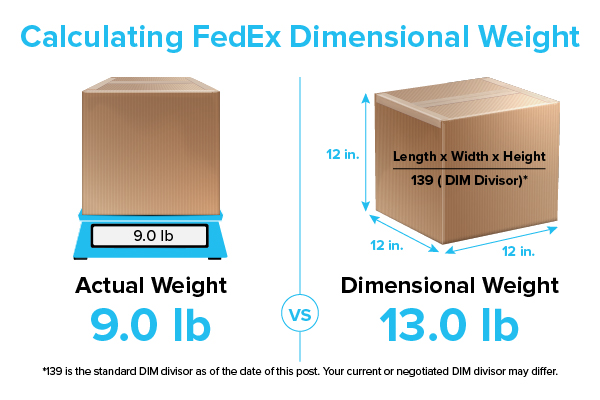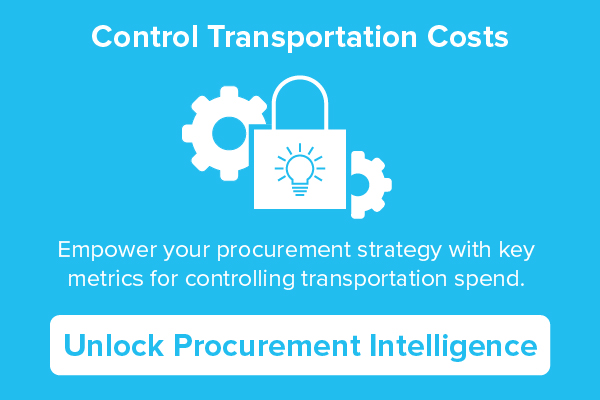FedEx Dimensional Weight Explained
FedEx dimensional weight can cause a lot of problems for customers. As a company that processes a tremendous amount of shipping data, we see a lot of issues with this.
Dimensional weight, also known as volumetric weight, is a pricing method employed by shipping carriers, including FedEx, that takes into account the size of a package in determining its shipping cost. This approach recognizes that both the size and weight of a package contribute to the cost of its transport.
One of the common issues we see is being billed at dimensional weight versus actual weight. So what does that even mean? To be able to understand how carrier pricing works, you have to look at three variables. The first variable is the service type that you are using. For example, with FedEx that could be a priority overnight shipment or a ground shipment. A priority overnight shipment is going to cost more than a FedEx ground shipment.
The second variable is the zone that you are using. So, in the United States, there are zones two through six. Now, the higher the zone the more expensive the rate for that particular package. Then, the third variable is billable weight. The higher the billable weight the more expensive the package. So those are the three variables that go into carrier pricing or that affect carrier pricing.
Calculating FedEx Dimensional Weight
When it comes to FedEx's dimensional weight, the shipping carrier uses a specific formula that considers not only the actual weight of the package but also the space it occupies in relation to its weight. This method calculates the dimensional weight by multiplying the package's length, width, and height (in inches), and then dividing that result by a standard dimensional factor, also known as the DIM factor or DIM divisor, currently set at 139. The resulting figure is compared to the package's actual weight, and the higher of the two is chosen as the billable weight for shipping costs.
You have a package, let's say it's 12 x 12 x 12 and it weighs nine pounds. Now, if we're billing only based on the actual weight the dimensions are irrelevant. That's a nine-pound package, so you're going to have a bill for nine pounds.
What FedEx does to account for package density is they look at the dimensions of a package. So for example, let's say you have the same nine-pound package in a box that is 12 x 12 x 12. FedEx is going to multiply those dimensions by a dimensional divisor or DIM divisor of 139. 139 is the standard DIM divisor. Now, what that comes out to is 13 pounds. So in this particular example, FedEx is going to bill you at 13 pounds instead of 9. So, the 13 pounds is the FedEx dimensional weight. They do this to account for the package density or lack thereof. This is to discourage customers from shipping light packages in big boxes. So the way they account for this is by looking at the FedEx dimensional weight.

If you're concerned about FedEx dimensional weight charges and how they might be affecting your shipping costs, Lojistic can provide a free parcel audit. This audit can help you understand and potentially reduce your shipping expenses, making your operations more cost-effective.
How FedEx Dimensional Weight Compares with Other Carriers
When we talk about FedEx dimensional weight, it's also beneficial to understand how this compares with other carriers. Carriers like UPS also use dimensional weight in their pricing, although the DIM divisors may vary. By comparing the dimensional weight policies of different carriers, you can make an informed decision about which carrier provides the best value for your specific shipping needs.
When dealing with dimensional weight charges, it's crucial to remember that carriers such as UPS and FedEx may have different policies and DIM factors. Lojistic can help you navigate and optimize both UPS and FedEx contracts, ensuring that your agreement is as advantageous as possible for your unique shipping requirements.
The Impact of FedEx Dimensional Weight
The influence of FedEx dimensional weight extends to various sectors. Businesses in industries such as e-commerce, manufacturing, and distribution can be heavily impacted. For e-commerce businesses, the cost of shipping can make a significant difference to the overall profitability. As more customers demand free shipping, understanding and managing FedEx dimensional weight becomes even more crucial.
On the other hand, manufacturers and distributors often have to send bulky but lightweight items, making them prime candidates for dimensional weight pricing. By implementing effective strategies like re-evaluating packaging practices, these businesses can potentially reduce shipping costs significantly.
Reducing FedEx Dimensional Weight Costs
So there are two ways you can address FedEx DIM weight pricing. First, look at your actual packaging! Make sure you are optimizing your packaging to make sure you are not shipping air or dead space. This is an obvious solution. Another one that a lot of customers don't realize is to look at the DIM factor.
So, as I mentioned, the current DIM divisor for FedEx is 139. That DIM divisor, before 2017, was 166. So, by negotiating an improved DIM divisor in your FedEx agreement you can lower the bill. Let's look at the same example we used earlier. That 12 x 12 x 12 package at a DIM divisor of 139 came out to 13 pounds. FedEx is going to bill you at 13 pounds because 13 pounds is greater than the actual weight of 9 pounds. Now let's say you were to negotiate an improved DIM divisor of 166. 12 x 12 x 12 divided by 166 comes out to 11 pounds. So in that same example, FedEx would bill you at 11 pounds versus 9 pounds.
How To Track The Impact
Still, you're getting a bill for a dimensional weight but you're getting the bill for two pounds less. So are you curious how the FedEx dimensional weight is impacting your business? Well, the Lojistic platform is a free tool you can use! You can connect your shipping carrier and see if you are being billed at DIM weight or actual weight. It will show you the impact that the FedEx dimensional weight is having on your business.
By utilizing Lojistic's shipping reporting and shipping analytics, you can achieve shipping optimization, effectively managing FedEx and UPS dimensional weight charges, and ensuring that your shipping operations are as efficient and cost-effective as possible.

Author
Bryan Van Suchtelen
Bryan Van Suchtelen
Corporate Director of Parcel Rate Services
Prior to joining Lojistic in 2015, Bryan enjoyed a 26-year career with UPS where his roles included Pricing, Field Sales and Director-level Sales Management of some of UPS’s largest customers.
At Lojistic, Bryan leverages his wealth of experience/expertise to identify and execute supply chain cost management solutions for parcel shippers of all sizes. Bryan has helped his customers reduce their shipping spend by tens of millions of dollars.

